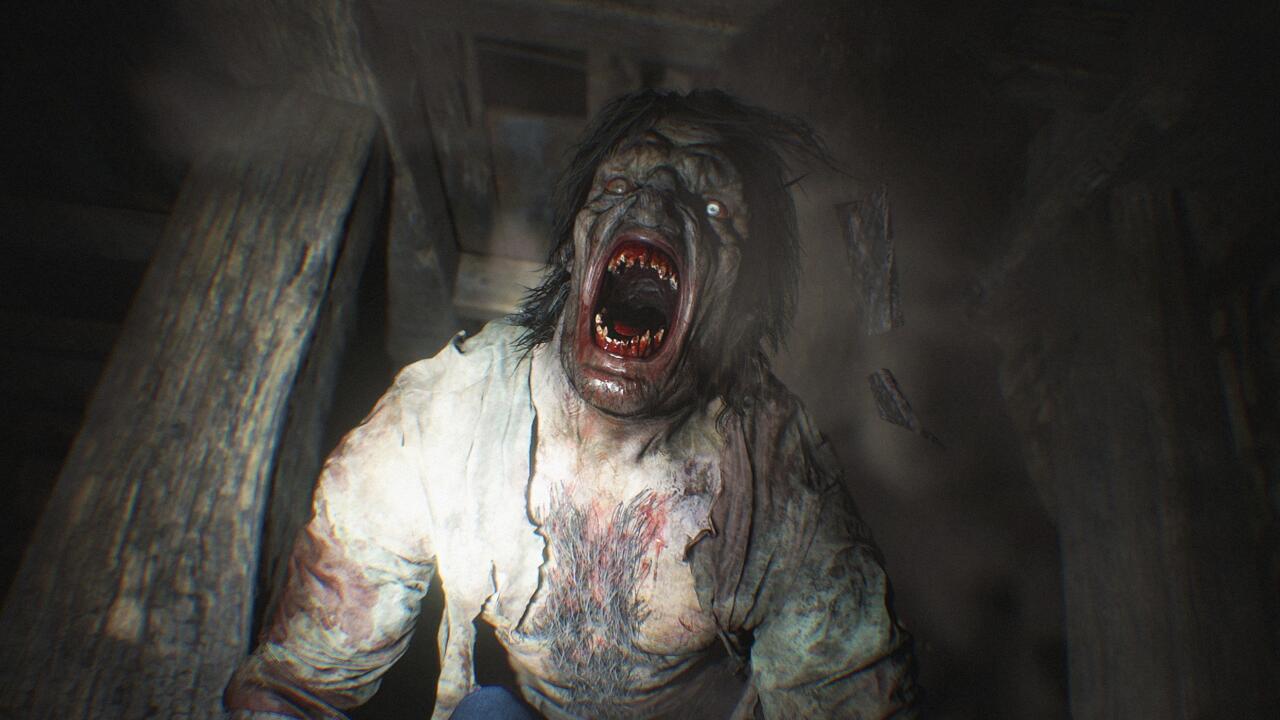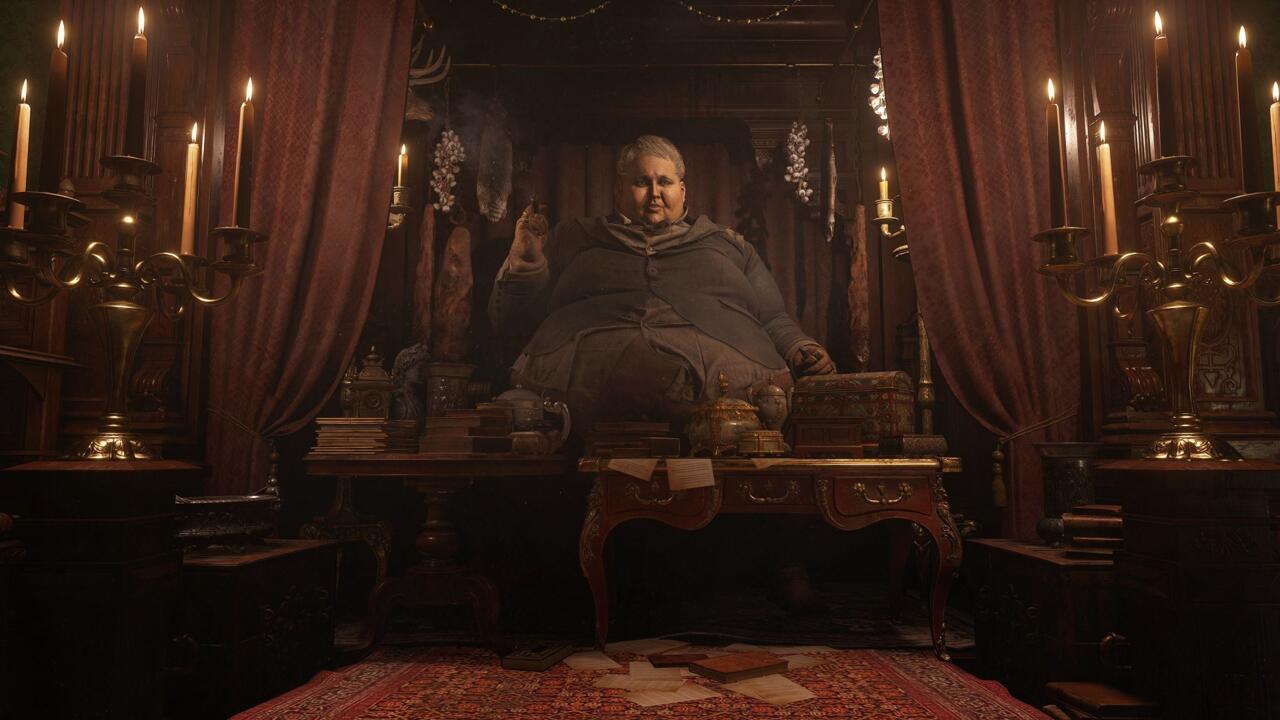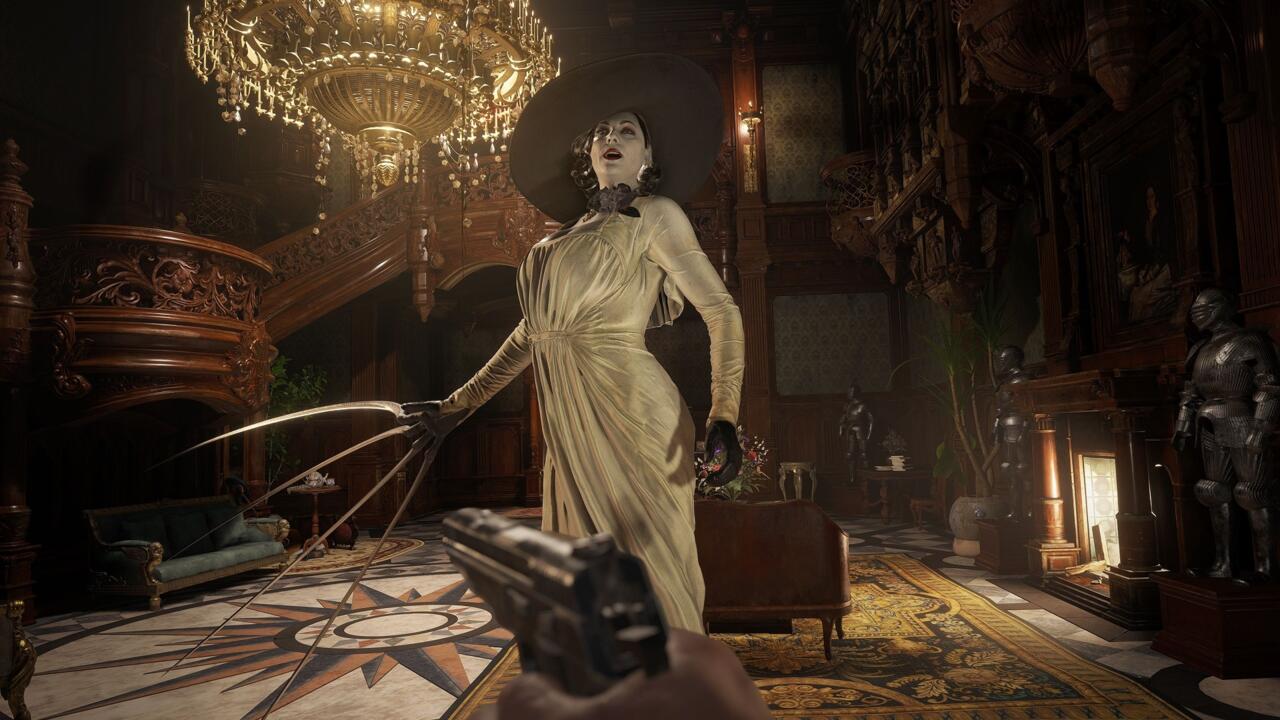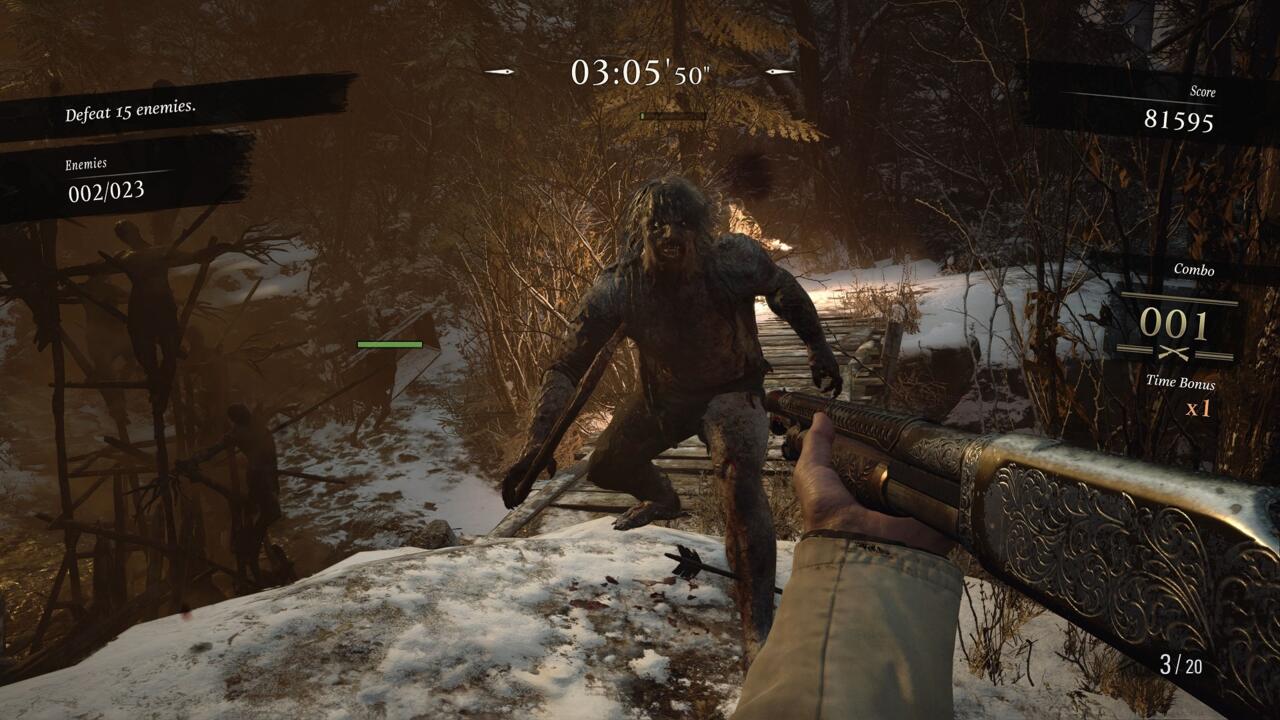Over its 25-year history, the Resident Evil series has continually changed and evolved, like a mad scientist who injects himself with a questionable bio-weapon, mutating into something new every time he shows up. For the most part, those evolutions have been fascinating recombinations of elements as Resident Evil tries different mixes of survival-horror and action gameplay. With Resident Evil 7, Capcom swung for the fences with a first-person perspective, a narrower scope, and more horror-focused gameplay. Resident Evil Village evolves that idea to make something that feels very different from its predecessor, but which is just as engaging.
Though the perspective and mechanical underpinnings are the same, Village branches off in its own direction from RE7, capturing some of the things that were great about that game while resisting the impulse to retread the same ground. While it's still frightening at points, it takes a less horror-driven tack on the same underlying first-person formula. Village continues to evolve Resident Evil while maintaining a keen grasp on some of its core tenets, finding new ways (or reviving old ones) of getting under your skin and ratcheting up the tension.
As has been pretty clear for a while now, Resident Evil Village is Resident Evil 7 through the lens of Resident Evil 4. When the latter was released way back in 2005, it significantly revamped what the franchise had been up to that point, swapping the earlier games' slower, survival-horror focus for a more fast-paced action approach. RE4 was scary because you were being overwhelmed by enemies, backed into corners, and chased by madmen wielding chainsaws. It traded darkened corridors and jump scares for adrenaline-fueled panic.
So while RE7 leans into the dark and creepy haunted house idea of the very first Resident Evil, Village transforms that take by taking cues from the faster, panickier RE4. It's again played from a tight, closed-in first-person perspective that has you constantly wondering what's behind you, and it still often focuses on slower movement and exploration through its gorgeous, twisting environments. But Village's approach is distinctly more action-centric, and it's remarkable how much Capcom has managed to push the formula of its reboot to the series in such a different direction.
Village picks up on Resident Evil 7's story three years later, again focusing on protagonist Ethan Winters. After rescuing his wife Mia from the Baker house and subsequently getting saved by Resident Evil franchise mainstay Chris Redfield, Ethan and Mia went into hiding with Chris' help, moving to Europe to restart their lives. They've since had a daughter, and while they're trying to put their lives back together, Ethan continues to struggle with the trauma he experienced. Mia, meanwhile, keeps trying to put the subject out of her mind and even seems to be struggling to remember it. But before Ethan can really get to the bottom of why his wife is acting kinda weird about the whole "survived being tormented in a house full of monsters" trauma they shared, Chris and his team bust into the couple's house and drag Ethan and baby Rose off.
Ethan wakes up some time later after a car crash. The two random special forces guys who were transporting him and Rose are dead. Ethan wanders through the snowy woods in search of his missing child, until he hits a ramshackle, seemingly empty village. Before long, he discovers it's under siege by what appear to be werewolves. It's all extremely reminiscent of the beginning of Resident Evil 4, which upended the RE formula by dropping you into a village overrun with enemies who acted like humans rather than shambling, mindless zombies. The lycans wield weapons and shoot arrows at you, and to avoid getting surrounded, you can run into houses and barricade the doors with furniture to slow their advances. The first major challenge in Village is to survive an onslaught of these creatures as you frantically try to create barricades, find weapons, and make a run for it before you're completely overwhelmed.

Just like its 2005 inspiration, the opening battle of Village taps into a frightening intensity of trying to create a defensible position or take part in a running gunfight that you're in serious danger of losing. It's a completely different feeling from the slow-burn dread of RE7, whose combat builds fear from the realization that the number of bullets in your gun is not the same as the number of bullets you need to kill one of its lumbering Molded enemies. But Village's combat can make your heart pound just as hard.
Really, the fact that Village feels like such a turn away from RE7 is what works about it--as a sequel, it feels like Capcom reaching for a new way to challenge itself. Most of the time in Village, at least on its standard difficulty, you'll find yourself well-outfitted for whatever you're about to face--the challenge is in using those resources effectively and keeping yourself alive. Village uses the same movement systems as RE7, which can feel a little slow and clunky at times; Ethan isn't especially agile and even at a sprint, it can feel like he's barely moving. Despite a sense of trudging through molasses, Village is tuned so that enemies also approach slowly and cautiously, so dealing with them comes together like a standoff that has you judging their moves or hitting their weak points before they have a chance to get in close and rip into you. It also adds to the tension as you try to navigate through areas to keep yourself out of danger--the first-person view means your awareness is very narrow, so staying hypervigilant about your surroundings is essential. Sometimes, you just have to run and hope you can find a better place to make your stand.
While the controls work for tense moments when surrounded, they feel a little wobblier in boss battles. Here, you're often dodging attacks as a monster charges you or swings at you with a huge weapon. You can absorb some damage with the ability to hold up your hands in a guard, another holdover from RE7 that helps mitigate the limitations of your movement, but the better strategy is to try to run around a battlefield and get out of the way. That usually means sacrificing seeing what your opponent is doing so you can make a quick dash one way or the other, and it's a bit of a weird way to fight. Since Ethan can't step sideways while looking forward, you're constantly just sort of running for it and hoping whatever is coming at you doesn't hit you. It doesn't make these boss battles frustrating or add to their difficulty, but it does add a counterintuitiveness to combat that can take you out of the moment.
Bullets are easy to come by, and if you're short, you can craft more from materials you find by searching your surroundings, or purchase them from the Duke, a traveling merchant with a penchant for showing up just when you need him. You'll find lots of guns and gun upgrades throughout the game, and you'll revisit the central town repeatedly to scour it for new hidden items. There's even a system for upgrading your character that involves animals like pigs and chickens scattered around the village. Shoot them and bring their meat to the Duke, he'll cook them into meals that increase your health, amp up your movement speed, or make your guard more effective.

All that stuff you're carrying around has to go somewhere, so Village brings back the inventory management system of RE4: You have a suitcase full of weapons, ammo, and health items, with each item taking up spaces on a grid. For most of the game, you probably won't have to worry about this, but as things wear on, you'll start to find yourself hauling more and more gear. You can move items around to make sure they all fit in your case, Tetris-style, and purchase bigger cases from the Duke so you can bring more stuff--but this system is most interesting when it starts making you wonder if you should sell off old guns or toss less useful items in favor of things like extra ammo. Mercifully, crafting materials aren't counted in your inventory, so you're free to make bullets and health items on the fly. But planning what you do and don't need to pick up becomes a consideration in exploration, albeit never a major one.
Though Village has far more variety of enemies to fight than RE7, it's not all shooting, with a lot of varied pacing and new challenges throughout. There are four different areas to unlock as you progress through the story, each headed by one of the Four Lords--the scary monster people who dominate the village and the area around it. The first is the castle run by Lady Dimitrescu (she of much internet fame), and while you'll spend lots of time popping the skulls of lycans in the village, there's a lot less shooting to be done in the castle portion. You'll occasionally face enemies you have to gun down, but much more time in the castle is spent navigating its tight corridors as Dimitrescu and her daughters--all seemingly vampires capable of turning themselves into clouds of bugs and recomposing themselves elsewhere--are hunting you. You can't kill Dimistrescu or her daughters with your conventional weapons, so you have to run if you're found. The entire level is spent exploring the castle, looking for the items you need to advance through the area, while listening for Dimistrescu's clomping footsteps and trying to keep away from her.
Even in this very first new area, Village is mixing and remixing its experience with the different horror ideas. You're not just shotgunning tons of enemies, you're also engaging in stealth that's much more akin to what navigating the Baker house was like in RE7. Later portions of the game throw different obstacles into your path. There are puzzle-heavy levels reminiscent of the mansion of Resident Evil or the police station of Resident Evil 2. There are sections where you hear frightfully powerful enemies in the distance, and knowing you're going to have to face them down, begin heaping ammo into your pockets in preparation. And there are points that show Village can also hone in on some of the intense frights that made RE7 so remarkable--points that are too damn good to spoil here.
Suffice to say that though Village gives you lots of guns and lets you use them, it also is great at maintaining an atmosphere of unease as you head around each new corner. You might have plenty of weapons, but can you handle what you're about to face? Will they even work against the next creature you encounter? There's an excellent balance between providing lots of action and maintaining that dread. This isn't the same kind of intense anxiety that RE7 conjured up, but Village encourages its own kind of fear, and it hits you with a few great RE7-like setpieces to ratchet up the tension when you least expect it. One particular "oh crap" moment with Dimitrescu comes to mind; others later in the game remind you that just because you have a lot of guns doesn't mean you're invincible.

No two sections of Village are quite the same, and each draws on different aspects of past Resident Evil games to combine them with the underlying RE7 feel to create something that's both new and nostalgic. It's impressive how deftly the game can change into something a little different again and again throughout its runtime, and each section is fun, intense, and, naturally, frightening in its own way. The result is a game that clips right along, constantly throwing something new at you but always feeling like an interesting new take on what you already know and have experienced. It's a hodgepodge of Resident Evil ideas, yes, but each one is executed exceedingly well--this is a game that seems aware of the franchise's entire history and is able to summon its best elements at will.
The caveat to that is the last hour of the game, where things take a weird, over-the-top turn. In the run-up to Village's final moments, the action gets turned up even higher, resulting in a final few enemy encounters that wind up feeling like needless digressions and don't add much to the overall package. Where past fights with hordes of lycans were intense affairs that required you to keep moving and pay careful attention to what you were facing, these last bits feel a bit like you've stepped through a portal into another game. For a few moments there, Village draws up the worst action-heavy portions of Resident Evil 6, losing track of what made you grit your teeth and clench your fists and exchanging it for something more akin to shooters like Call of Duty.
This same moment highlights some of the inconsistency in Village's story. Despite pre-release imagery focused on the Umbrella corporation's logo appearing in the game, the way that Village connects with the larger RE franchise feels a bit tacked on. The same is true of Chris Redfield, who shows up here and there to say something cryptic without really revealing anything. The focus on Ethan's interactions with the Four Lords and uncovering what's going on in the village is more fun and interesting--these are antagonists who come off as petty and human. They don't particularly like each other but are all eager to torture and maim you anyway, and their interactions with Ethan and each other add dimension to their characters. In all, this isn't the best Resident Evil story, but it is a spooky romp with fun villains. It's just a shame that more time wasn't devoted to pulling on all the hanging story threads of RE7, or in tying it together with the franchise at large.
Thankfully, the late-game digression doesn't last long, and the elements about the combat that are fun--the one-on-one or one-on-too-many sparring nature of fights, and finding ways to take down tough enemies before they can rip you apart--are transplanted into the fast-paced arcade mode The Mercenaries. This also feels like a lift straight out of Resident Evil 4; it takes the combat of Village, slaps a timer on it, and focuses it on scoring points. The Mercenaries is a fun side activity in its own right, always daring you to get a higher score by balancing taking down enemies quickly and trying to complete one of its given levels as fast as you can. It demonstrates how tight the combat in Village can be, although at times it can be held back a bit by the slow, underwater-feeling of movement around the battlefield.

Another aspect of the Village package is Resident Evil Re:Verse, a multiplayer-focused mode in which you fight other players as both Resident Evil characters and monsters. Re:Verse is slated to release separately sometime this summer for Village buyers, but it wasn't included with our review copy.
Resident Evil 7 was an excellent return to the horror underpinnings of the franchise, but cunningly altered with new ideas and a new perspective. Similarly, Village is an intelligent reintroduction of the best action elements of Resident Evil. Though it captures some of the same things that made RE7 such a breath of fresh air (or maybe rancid, stale, mold-filled air, but in a good way), Village evolves to become its own unique creature. It makes you wonder what beautifully twisted fiend Resident Evil might mutate into in the future.
































